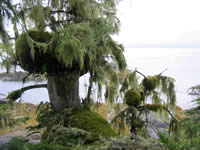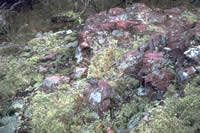USDA Forest Service Celebrating Wildflowers
|
|
|
 |
|
Why are lichens important?Lichens are important for several reasons. One of the most obvious is that they are beautiful to look at. How enchanting would the Pacific Northwest be without the long drapes of Alectoria sarmentosa (witch’s hair) hanging from the branches of the old Douglas firs and Sitka spruce? How colorful would the rocks and cliffs be in the Rocky Mountains without the reds, yellows, and greens of the crust lichens? Without these living creatures hanging off of trees or clinging to rocks, our natural areas would look pretty boring and a little more lifeless. Another important function of lichens is that they provide a mode of survival in harsh environments where algae cannot normally survive. Since the fungus can protect its algae, these normally water-requiring organisms can live in dry, sunny climates without dying, as long as there are occasional rain showers or flooding to let them recharge and store food for the next drought period. Because lichens enable algae to live all over the world in many different climates, they also provide a means to convert carbon dioxide in the atmosphere through photosynthesis into oxygen, which we all need to survive. One of the ways lichens directly benefit humans is through their ability to absorb everything in their atmosphere, especially pollutants. Lichens can provide us with valuable information about the environment around us. Any heavy metals or carbon or sulfur or other pollutants in the atmosphere are absorbed into the lichen thallus. Scientists can extract these toxins and determine the levels that are present in our atmosphere. The United States Forest Service National Lichens & Air Quality Database and Clearinghouse provides more information about lichen biomonitoring and how it is helping federal land managers meet federal and agency responsibilities to detect, map, evaluate trends, and assess the ecological impacts of air pollutants. |
|
| NOTE: PDF format links require the Adobe Acrobat Reader to view. | |
| top | Disclaimers | FOIA | Privacy Policy | Quality of Information | Photo Credits & Use |
Location: http://www.fs.fed.us/wildflowers/interesting/lichens/importance.shtml
Last modified: Tuesday, 24-Jun-2008 21:54:36 EDT

